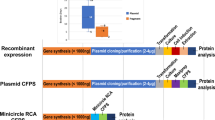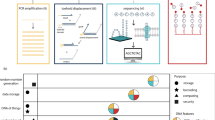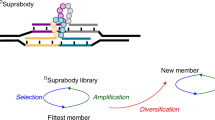Abstract
Robust high-throughput synthesis methods are needed to expand the repertoire of repetitive protein-polymers for different applications. To address this need, we developed a new method, overlap extension rolling circle amplification (OERCA), for the highly parallel synthesis of genes encoding repetitive protein-polymers. OERCA involves a single PCR-type reaction for the rolling circle amplification of a circular DNA template and simultaneous overlap extension by thermal cycling. We characterized the variables that control OERCA and demonstrated its superiority over existing methods, its robustness, high-throughput and versatility by synthesizing variants of elastin-like polypeptides (ELPs) and protease-responsive polymers of glucagon-like peptide-1 analogues. Despite the GC-rich, highly repetitive sequences of ELPs, we synthesized remarkably large genes without recursive ligation. OERCA also enabled us to discover ‘smart’ biopolymers that exhibit fully reversible thermally responsive behaviour. This powerful strategy generates libraries of repetitive genes over a wide and tunable range of molecular weights in a ‘one-pot’ parallel format.
This is a preview of subscription content, access via your institution
Access options
Subscribe to this journal
Receive 12 print issues and online access
$259.00 per year
only $21.58 per issue
Buy this article
- Purchase on Springer Link
- Instant access to full article PDF
Prices may be subject to local taxes which are calculated during checkout






Similar content being viewed by others
References
Mackay, J. A. & Chilkoti, A. Temperature sensitive peptides: Engineering hyperthermia-directed therapeutics. Int. J. Hyperthermia 24, 483–495 (2008).
Chow, D., Nunalee, M. L., Lim, D. W., Simnick, A. J. & Chilkoti, A. Peptide-based biopolymers in biomedicine and biotechnology. Mater. Sci. Eng. R-Rep. 62, 125–155 (2008).
Nettles, D. L. et al. In situ crosslinking elastin-like polypeptide gels for application to articular cartilage repair in a goat osteochondral defect model. Tissue Eng. Part A 14, 1133–1140 (2008).
Dreher, M. R. et al. Temperature triggered self-assembly of polypeptides into multivalent spherical micelles. J. Am. Chem. Soc. 130, 687–694 (2008).
Simnick, A. J., Lim, D. W., Chow, D. & Chilkoti, A. Biomedical and biotechnological applications of elastin-like polypeptides. Polym. Rev. 47, 121–154 (2007).
Rao, X. C. et al. Design and expression of peptide antibiotic hPAB-beta as tandem multimers in Escherichia coli. Peptides 26, 721–729 (2005).
Lee, J. H., Kim, M. S., Cho, J. H. & Kim, S. C. Enhanced expression of tandem multimers of the antimicrobial peptide buforin II in Escherichia coli by the DEAD-box protein and trxB mutant. Appl. Microbiol. Biotechnol. 58, 790–796 (2002).
Wang, Y. Q. & Cai, J. Y. High-level expression of acidic partner-mediated antimicrobial peptide from tandem genes in Escherichia coli. Appl. Biochem. Biotechnol. 141, 203–213 (2007).
Hou, J. H. et al. High-level expression of fusion protein containing 10 tandem repeated GLP-1 analogs in yeast Pichia pastoris and its biological activity in a diabetic rat model. Biosci. Biotechnol. Biochem. 71, 1462–1469 (2007).
Kempe, T. et al. Multiple-copy genes—production and modification of monomeric peptides from large multimeric fusion proteins. Gene 39, 239–245 (1985).
Ma, X. et al. Poly-GLP-1, a novel long-lasting glucagon-like peptide-1 polymer, ameliorates hyperglycaemia by improving insulin sensitivity and increasing pancreatic beta-cell proliferation. Diabetes Obes. Metab. 11, 953–965 (2009).
Prasad, S., Mathur, A., Jaggi, M. & Mukherjee, R. Delivering multiple anticancer peptides as a single prodrug using lysyl-lysine as a facile linker. J. Pept. Sci. 13, 458–467 (2007).
Meyer, D. E. & Chilkoti, A. Genetically encoded synthesis of protein-based polymers with precisely specified molecular weight and sequence by recursive directional ligation: Examples from the elastin-like polypeptide system. Biomacromolecules 3, 357–367 (2002).
Clarke, L. A., Rebelo, C. S., Goncalves, J., Boavida, M. G. & Jordan, P. PCR amplification introduces errors into mononucleotide and dinucleotide repeat sequences. J. Clin. Pathol. Mol. Pa. 54, 351–353 (2001).
Frey, U. H., Bachmann, H. S., Peters, J. & Siffert, W. PCR-amplification of GC-rich regions: ‘Slowdown PCR’. Nature Protoc. 3, 1312–1317 (2008).
White, M. J., Fristensky, B. W. & Thompson, W. F. Concatemer chain reaction: A Taq DNA polymerase-mediated mechanism for generating long tandemly repetitive DNA sequences. Anal. Biochem. 199, 184–190 (1991).
MacEwan, S. R. & Chilkoti, A. Elastin-like polypeptides: Biomedical applications of tunable biopolymers. Biopolymers 94, 60–77 (2010).
Urry, D. W., Urry, K. D., Szaflarski, W. & Nowicki, M. Elastic-contractile model proteins: Physical chemistry, protein function and drug design and delivery. Adv. Drug. Deliv. Rev. (2010).
Bochicchio, B., Pepe, A. & Tamburro, A. M. Investigating by CD the molecular mechanism of elasticity of elastomeric proteins. Chirality 20, 985–994 (2008).
Yamaoka, T. et al. Mechanism for the phase transition of a genetically engineered elastin model peptide (VPGIG)(40) in aqueous solution. Biomacromolecules 4, 1680–1685 (2003).
Meyer, D. E. & Chilkoti, A. Quantification of the effects of chain length and concentration on the thermal behaviour of elastin-like polypeptides. Biomacromolecules 5, 846–851 (2004).
Li, H. et al. A protease-based strategy for the controlled release of therapeutic peptides. Angew. Chem. Int. Ed. Engl. 49, 4930–4933 (2010).
Mi, L. X. Molecular cloning of protein-based polymers. Biomacromolecules 7, 2099–2107 (2006).
Kurihara, H., Morita, T., Shinkai, M. & Nagamune, T. Recombinant extracellular matrix-like proteins with repetitive elastin or collagen-like functional motifs. Biotechnol. Lett. 27, 665–670 (2005).
Kurihara, H. & Nagamune, T. DNA polymerase-catalyzed elongation of repetitive hexanucleotide sequences: Application to creation of repetitive DNA libraries. Biotechnol. Prog. 20, 1855–1860 (2004).
Bang, D. H. & Church, G. M. Gene synthesis by circular assembly amplification. Nature Methods 5, 37–39 (2008).
Lyons, R. E. et al. Design and facile production of recombinant resilin-like polypeptides: Gene construction and a rapid protein purification method. Protein Eng. Design Selection 20, 25–32 (2007).
Fire, A. & Xu, S. Q. Rolling replication of short DNA circles. Proc. Natl Acad. Sci. USA 92, 4641–4645 (1995).
Zhang, D. Y., Brandwein, M., Hsuih, T. C. H. & Li, H. B. Amplification of target-specific, ligation-dependent circular probe. Gene 211, 277–285 (1998).
Zhang, W. D. et al. Detection of Chlamydia trachomatis by isothermal ramification amplification method: A feasibility study. J. Clin. Microbiol. 40, 128–132 (2002).
Lee, B. W. et al. Strongly binding cell-adhesive polypeptides of programmable valencies. Angew. Chem. Int. Ed. 49, 1971–1975 (2010).
Lv, S. et al. Designed biomaterials to mimic the mechanical properties of muscles. Nature 465, 69–73 (2010).
McDaniel, J. R., MacKay, J. A., Quiroz, F. G. & Chilkoti, A. Recursive directional ligation by plasmid reconstruction allows rapid and seamless cloning of oligomeric genes. Biomacromolecules 11, 944–952 (2010).
Christensen, T. et al. Fusion order controls expression level and activity of elastin-like polypeptide fusion proteins. Protein Sci. 18, 1377–1387 (2009).
Baggio, L. L., Huang, Q. L., Brown, T. J. & Drucker, D. J. A recombinant human glucagon-like peptide (GLP)-1-albumin protein (Albugon) mimics peptidergic activation of GLP-1 receptor-dependent pathways coupled with satiety, gastrointestinal motility, and glucose homeostasis. Diabetes 53, 2492–2500 (2004).
Acknowledgements
A.C. acknowledges the financial support of NIH grants R21 EB009904 and R01 GM61232, M.A. acknowledges the support of a graduate fellowship from the Center for Biologically Inspired Materials and Material Systems, and F.G.Q. acknowledges the support of a fellowship from the Medtronic Foundation.
Author information
Authors and Affiliations
Contributions
A.C. designed experiments, analysed data and prepared the manuscript. M.A. and F.G.Q. designed and performed experiments, analysed data and prepared the manuscript. D.J.C. designed experiments.
Corresponding author
Ethics declarations
Competing interests
The authors declare no competing financial interests.
Supplementary information
Supplementary Information
Supplementary Information (PDF 1354 kb)
Rights and permissions
About this article
Cite this article
Amiram, M., Quiroz, F., Callahan, D. et al. A highly parallel method for synthesizing DNA repeats enables the discovery of ‘smart’ protein polymers. Nature Mater 10, 141–148 (2011). https://doi.org/10.1038/nmat2942
Received:
Accepted:
Published:
Issue Date:
DOI: https://doi.org/10.1038/nmat2942
This article is cited by
-
The construction of elastin-like polypeptides and their applications in drug delivery system and tissue repair
Journal of Nanobiotechnology (2023)
-
Combinatorial codon scrambling enables scalable gene synthesis and amplification of repetitive proteins
Nature Materials (2016)
-
Structural ensembles reveal intrinsic disorder for the multi-stimuli responsive bio-mimetic protein Rec1-resilin
Scientific Reports (2015)
-
Sequence heuristics to encode phase behaviour in intrinsically disordered protein polymers
Nature Materials (2015)
-
An overhang-based DNA block shuffling method for creating a customized random library
Scientific Reports (2015)



